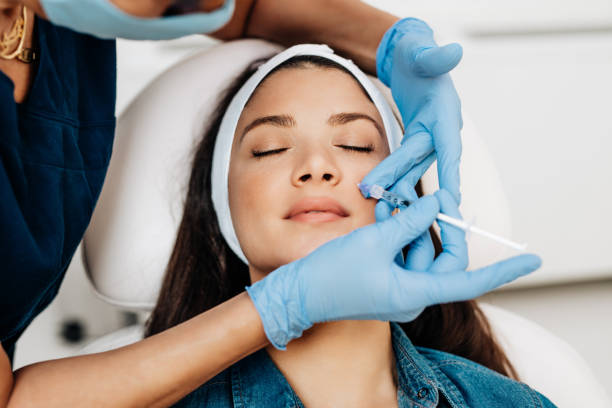
Dermal fillers are an effective and popular solution for cosmetic enhancements, but the longevity of the treatment may vary depending on several factors.
Here are some of the most common factors that can impact how long dermal fillers last:
- Type of filler used: Different types of dermal fillers last different amounts of time. Hyaluronic acid fillers tend to last 6-18 months while collagen fillers may only last 4-6 months.
- Location of the injections: Areas of high movement, such as the lips or cheeks, may reduce the duration of the treatment.
- Metabolism: Depending on your metabolism, your body may break down the filler more quickly.
- Sun exposure: Exposure to the sun can break down the components of the filler, leading to a shortened duration.
- Lifestyle habits: Smoking, drinking, and poor nutrition can all decrease the longevity of dermal fillers.
In general, proper aftercare and lifestyle habits can significantly extend the life of your dermal fillers. Be sure to choose a reputable provider and follow their aftercare instructions for the best results.
Types of Dermal Fillers and Their Longevity
Dermal fillers are a popular cosmetic procedure used to help reduce the appearance of wrinkles, lines, and other signs of aging. Different types of dermal fillers have different longevity, some lasting for just 6 months and others lasting up to a year or more. In this article, we will explore the different types of fillers and discuss their longevity, as well as other factors that can affect how long a dermal filler lasts.
Understanding Different Types of Fillers
There are several types of dermal fillers available today, each with its unique composition and longevity. Understanding the different types of fillers can help you choose the right one for your desired results and budget.
- Hyaluronic Acid Fillers: These fillers are made of a natural substance found in the skin, making them safe and effective for filling fine lines and wrinkles. They last, on average, 6-12 months.
- Calcium Hydroxylapatite Fillers: These fillers stimulate natural collagen production while adding volume to the skin. They last around 12-18 months.
- Poly-L-Lactic Acid Fillers: These fillers work by stimulating collagen production, resulting in a gradual improvement in skin volume and texture. They last around 2 years.
- PMMA Fillers: These fillers contain synthetic, non-biodegradable microspheres and require the least amount of maintenance. They are long-lasting and can be permanent.
Factors that can affect the longevity of dermal fillers include the type of filler chosen, injection technique, and the individual’s metabolism.
Average Longevity of Popular Fillers
The longevity of dermal fillers varies greatly depending on the type of filler used, the area of injection, and various individual factors that affect the life of the product.
Generally, the average lifespan of popular dermal fillers ranges from 6 months to 2 years:
- Hyaluronic acid fillers: These fillers last from 6 to 18 months, with some newer formulations lasting up to 2 years.
- Sculptra: This filler is different from others in that it stimulates the body to produce its collagen; thus, it can last up to 2 years or longer.
- Calcium hydroxylapatite fillers: The effects of these fillers can last up to 18 months.
Factors that can affect the longevity of dermal fillers include the patient’s age, skin thickness, lifestyle, and the amount and type of filler used. To extend the life of your dermal filler, avoid sun exposure, follow a healthy lifestyle, and use quality skin care products.
Factors That Influence Longevity
The longevity of dermal fillers varies depending on multiple factors such as the type of filler used, where it is injected, and the patient’s unique metabolism.
Here are some of the factors that affect the longevity of dermal fillers:
- Type of filler: Some fillers, like hyaluronic acid-based fillers, last for 6 to 12 months, while others, such as calcium hydroxylapatite-based fillers, can last up to 18 months or more.
- Location of the injection: Fillers injected into areas with a lot of facial movement, like around the mouth, tend to break down faster than those injected into areas with less movement, like the cheekbones.
- Metabolism: Every patient’s metabolism is different, so the longevity of fillers can vary from person to person. Patients with faster metabolisms tend to break down fillers more quickly.
- Injection technique: The skill and technique of the injector can also affect the longevity of dermal fillers. An experienced injector knows how to inject the fillers properly to ensure optimal effectiveness and longevity.
To ensure the longest possible duration of your filler, it is recommended to choose the right type of filler for the targeted area and to rely only on an experienced and licensed injector.

Patient-Related Factors Affecting The Longevity Of Dermal Fillers
One of the most important factors that influence how long dermal fillers last is the individual patient and their unique characteristics. These patient-related factors such as age, lifestyle, the type of dermal filler used, and even the technique used by the medical practitioner can all have an impact on the longevity of dermal fillers. In this article, we’ll explore how these various factors can play a role in the longevity of dermal fillers.
Skin Age and Condition
The age and condition of your skin are crucial factors that affect the longevity of dermal fillers. As you age, your skin produces less collagen, hyaluronic acid, and elastin, which are essential components that provide a youthful appearance. This natural aging process leads to wrinkles, fine lines, and sagging skin.
Dermal fillers work by restoring volume and plumpness to your skin, but their effectiveness and longevity depend on several factors such as:
- The amount of product injected
- The area of injection
- Your metabolism
- Your lifestyle
- Your skin’s condition
If you have healthy and hydrated skin, the dermal fillers might last longer. Similarly, if you avoid smoking and maintain a healthy diet and lifestyle, you can prolong the impact of your dermal fillers. However, if you have excessively oily, acne-prone or scarred skin, the longevity of your dermal fillers might be reduced. Therefore, consult with your dermatologist to determine whether dermal filler injections are suitable for your skin type and condition.
Lifestyle and Habits
The longevity of dermal fillers is affected by various patient-related factors linked to their lifestyle and habits. Some of these factors are:
- Smoking: Smoking can contribute to premature aging of the skin and weaken the effects of dermal fillers, shortening their lifespan.
- Sun exposure: Excessive sun exposure can cause skin damage and hasten the degradation of fillers, reducing their longevity.
- Alcohol consumption: Regular alcohol consumption can dehydrate the skin, causing the filler to dissolve faster.
- Exercise: Rigorous exercise soon after the treatment can interfere with the settling of the filler, resulting in reduced longevity.
- Skincare routine: Certain skincare products, especially harsh exfoliants, can break down the filler and reduce its lifespan.
- Stress: High stress can cause changes in hormones that can break down the filler quickly.
As a patient, it’s important to be aware of these factors, and make necessary changes to your lifestyle or habits to maximize the benefits of your dermal filler treatment.
Pro tip: Always consult with a trained medical professional to ensure the best results from your dermal filler treatment.
Health Conditions and Medications
Several patient-related factors play a role in the longevity of dermal fillers, including health conditions and medications.
- Health conditions: Patients with autoimmune diseases such as lupus, rheumatoid arthritis, and scleroderma may experience faster metabolization of dermal fillers due to increased immune activity. Patients with poor blood circulation, smoking, or skin conditions like acne may also experience a shorter lifespan of their fillers.
- Medications: Patients taking medications that suppress the immune system, such as chemotherapy or corticosteroids, may experience a shorter lifespan of their dermal fillers. Blood-thinning medications like aspirin and ibuprofen may also increase the risk of bruising and swelling after filler injections.
Overall, it’s essential to discuss your medical history and any medications you’re taking with your dermatologist or injector before getting dermal filler injections. This way, they can determine the most suitable approach to optimize the longevity of your fillers.
Practitioner-Related Factors Affecting the Longevity of Dermal Fillers
Dermal fillers are becoming increasingly popular as an alternative to more invasive cosmetic procedures. However, the longevity of these treatments will largely depend on the skill and experience of the practitioner administering the treatment. In this section, we will discuss the practitioner-related factors that can influence the longevity of dermal fillers.
Experience and Technique of the Practitioner
The experience and technique of the practitioner are essential factors in determining the longevity of dermal fillers. A skilled and experienced practitioner can ensure that the fillers are placed properly and in the right quantity to provide long-lasting results. However, if the practitioner is not experienced or trained correctly, the fillers may not be placed correctly or may be over-injected, leading to an uneven result or shorter longevity.
Moreover, the technique used by the practitioner during the injection process can also impact the lasting results of dermal fillers. If the practitioner uses the correct technique, it ensures the fillers spread evenly and integrate with the tissue seamlessly. Therefore, it is crucial to choose a certified and experienced practitioner to perform the procedure correctly, ensuring that the dermal fillers last as long as possible. Pro tip: Do your research and pick a practitioner who has a good track record and positive reviews.
Type and Quality of the Dermal Filler
The type and quality of the dermal filler used is a key factor that affects the longevity of the treatment. Generally, the thicker and heavier the filler, the longer it lasts. However, this is not always the case, and the longevity of the treatment also depends on a variety of other factors associated with the practitioner and the technique used.
Factors that affect the longevity of dermal fillers include:
- The experience and skill of the practitioner.
- The injection technique used.
- The area of the face where the filler is injected.
- The individual’s metabolism and lifestyle factors.
- The quality and purity of the filler used.
Patients can expect dermal fillers to last anywhere from 6 to 18 months, depending on these factors. By choosing a qualified and experienced practitioner and discussing their unique needs and lifestyle factors, patients can ensure the best possible results from their dermal filler treatment.
Amount of Filler Injected
The amount of filler injected is a crucial practitioner-related factor that affects the longevity of dermal fillers. Injecting too much or too little filler can impact how long the results last. Injecting too much filler can lead to an overfilled, unnatural look and can put excess pressure on the skin, causing the filler to break down more quickly. On the other hand, injecting too little filler may result in areas where the skin is not plumped enough and can require additional touch-up sessions to maintain results.
The optimal amount of filler needed depends on various factors such as the treatment area, the severity of the wrinkles or volume loss, and the patient’s skin type and condition. It is important to discuss the desired results and expectations with the practitioner to ensure the right amount of filler is injected for the best and longer-lasting results.
Pro tip: Choose an experienced and licensed practitioner who has a good understanding of facial anatomy and injects the appropriate amount of filler for natural-looking and long-lasting results.

How Long Do Dermal Fillers Last
When considering dermal fillers, it is important to understand the factors that can affect how long they last. Injection site-related factors such as anatomic location, surrounding tissue, and depth of the injection can all have an impact on the longevity of dermal fillers. This article will cover the effects of these factors on the longevity of dermal fillers.
Location of Injection
The location of injection plays a crucial role in the longevity of dermal fillers. Different areas of the face have different properties that can impact how long the fillers last. Areas with more muscle movement, such as the lips and cheeks, may break down the fillers more quickly, leading to a shorter lifespan. In contrast, areas with less muscle movement, such as the under-eye area and temples, may provide a longer-lasting effect.
The injection technique also plays a role in how long dermal fillers last. Injecting fillers too deeply or not massaging them adequately can impact their longevity. Other factors that can affect how long dermal fillers last include the type of filler used, the patient’s age, and their lifestyle habits. By consulting with a trained and experienced practitioner and taking proper care of the injection site, patients can optimize the longevity of their dermal filler treatment.
Injection Depth and Technique
The longevity of dermal fillers depends on several factors, including injection depth and technique. The proper injection depth and technique play a crucial role in maximizing the lifespan of dermal fillers.
Here are some factors to consider when it comes to injection depth and technique:
- Proper Injection Depth: Injecting the dermal filler too superficially can result in a short-lived effect, while injecting it too deeply can cause an overfilled or unnatural appearance. The optimal injection depth varies depending on the area being treated and the type of dermal filler being used.
- Proper Injection Technique: The technique used to inject the dermal filler can have a significant impact on its longevity. An experienced injector will use a ‘microdroplet’ technique, where small amounts of filler are placed evenly throughout the treatment area, resulting in a more natural and long-lasting effect.
In addition to injection depth and technique, other factors such as the type of dermal filler used and the individual’s skin type can also affect the longevity of dermal fillers. Overall, choosing an experienced injector who uses the proper injection depth and technique can help maximize the lifespan of your dermal fillers.
Product Dilution and Mixing
Product dilution and mixing play a crucial role in the longevity of dermal fillers. A highly concentrated filler is likely to be metabolized and absorbed by the body faster, reducing its longevity. Properly mixing and diluting a filler can enhance its longevity and overall effectiveness.
Factors that affect the longevity of dermal fillers include the injection site, depth of injection, quality and quantity of the filler used, and the patient’s lifestyle and metabolism. Using high-quality fillers like Juvederm, Restylane, and Sculptra and following a proper injection technique, can extend the lifespan of the dermal filler to up to six months or a year. To enhance the longevity of dermal filler, it’s important to avoid smoking, excessive sun exposure, and other habits that can break down collagen and elastin in the skin.
Pro tip: You should discuss the longevity of the dermal filler before the procedure with your dermatologist, as some fillers are better suited for certain areas of the face than others.
Aftercare and Maintenance of Dermal Fillers
Taking proper care and maintenance of your dermal fillers can elongate their life. There are various factors that can affect the longevity of your results, such as lifestyle changes, health, skincare regimens, and aftercare treatments.
This section will address all these factors that affect the longevity of dermal fillers and what you can do to maximize the longevity of your results.
Post-Treatment Instructions
Dermal fillers can create a more youthful appearance by enhancing facial features and restoring skin volume. However, post-treatment instructions and aftercare play a crucial role in maximizing the longevity of your dermal fillers.
Here are some aftercare and maintenance tips to keep in mind:
- Avoid exposure to direct sunlight and high temperatures for the first 24 hours after treatment.
- Refrain from applying makeup or touching the treated area for at least 6 hours.
- Avoid strenuous exercise for 24 hours after treatment.
- Refrain from consuming alcohol for the first 24 hours.
- Avoid taking blood-thinning medication, such as aspirin or ibuprofen, for at least 24 hours after treatment.
Furthermore, the longevity of dermal fillers depends on various factors, including the type and quality of the filler used, the treatment area, and the individual’s metabolism. On average, most dermal fillers last between 6 and 18 months. In some cases, touch-up treatments may be required to maintain desired results.
Pro tip: To ensure optimal results and longevity, it’s essential to consult with a qualified and experienced professional for dermal filler treatments.
Follow-Up Appointments
Follow-up appointments are crucial for the aftercare and maintenance of dermal fillers as they help ensure the longevity of the treatment. During the follow-up appointment with your dermatologist, they will assess the results of the procedure and recommend any necessary touch-ups or additional treatments.
Various factors can affect the longevity of dermal fillers, including the type of filler used, the treatment area, and individual lifestyle habits. Smoking, excessive sun exposure, and poor skin care can all contribute to the breakdown of the filler and reduce its effectiveness over time.
To extend the lifespan of your dermal fillers, it’s important to maintain a healthy lifestyle and follow your dermatologist’s instructions for post-treatment care, such as avoiding certain skincare products and minimizing sun exposure. It’s generally recommended to schedule follow-up appointments every 6-12 months to maintain the desired results of your dermal filler treatment.
Pro tip: To ensure the best possible outcome for your dermal filler treatment, choose a qualified and experienced dermatologist who can guide you through the entire process and provide personalized recommendations for aftercare.
Products and Treatments That Can Prolong Filler Life
Dermal fillers are a popular cosmetic treatment designed to restore volume and fullness to the skin, but the results are not permanent. However, there are products and treatments available that can help to prolong the life of your dermal fillers.
Here are some of the factors that can affect the longevity of your dermal fillers and ways to extend their lifespan:
- Hydration: Drinking plenty of water can help to keep your skin hydrated and improve the longevity of your filler.
- Sun Protection: Prolonged exposure to the sun can break down the hyaluronic acid in fillers, causing them to break down faster. Applying sunscreen regularly can help to protect your skin and maintain the life of your fillers.
- Topical Products: Using skincare products with active ingredients, such as retinol and glycolic acid, can break down the filler more quickly. Avoid using these products on the treated area.
- Touch-Ups: Regular touch-ups can help to maintain the results of your dermal fillers and extend their lifespan.
- Other treatments: Facial massage, facial acupuncture, and ultrasound therapy can stimulate collagen production, helping to prolong the filler life.
Pro tip: Consult with a dermatologist to better understand how to care for your dermal fillers and improve their longevity.










